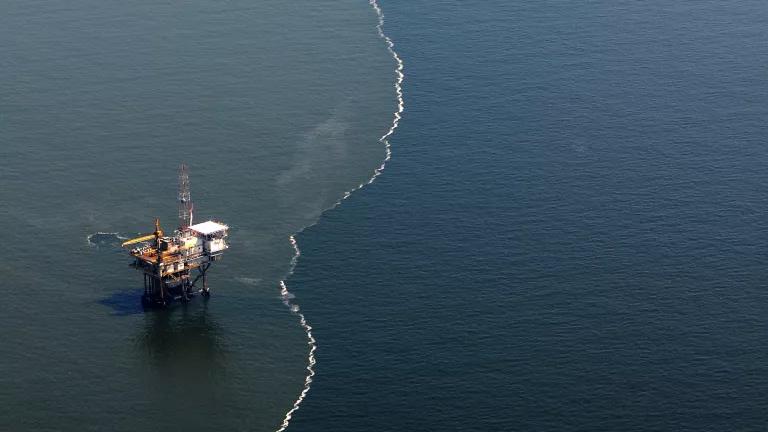The U.S. Needs Clean Energy, Not More Oil and Gas Leasing
To meet our climate commitments, the United States must significantly reduce its current level of fossil fuel exploitation and not develop fossil fuel reserves in new areas.

An aerial view of a line of dispersing oil moving past an offshore drilling rig in the Gulf of Mexico on May 26, 2010, following a massive spill from the BP disaster on May 4.
U.S. Coast Guard
Amid a worsening climate crisis, senseless war in Ukraine, and soaring energy prices, some are calling for the Secretary of the Interior to conduct new offshore oil and gas leasing in the next five-year program. But opening up more of our ocean to polluting drilling would have no impact on current prices or production. New offshore leasing doesn’t result in oil supply hitting the market for five or more years, and the fossil fuel industry is already sitting on leases that could produce oil and gas at current levels for a decade. The only thing new leasing would do is lock in fossil fuel infrastructure and climate pollution for decades, even as our planet continues to warm.
Today, we are releasing a new issue brief: The Case Against New Offshore Oil and Gas Leasing on the Outer Continental Shelf. The Secretary of the Interior is empowered under the law to determine what will best meet national energy needs. And it begins with a five year program that offers no new leasing.
The Secretary of Interior should propose a five-year leasing program with no lease sales because:
- the impacts of no new leasing on current U.S. oil and gas production would be negligible given the substantial oil reserves already under lease (a projected reduction in production of only 2 percent by 2035);
- the U.S. economy's demand for fossil fuels is expected to significantly decline in the coming years thanks to efficiency, electrification technologies, and transportation and other policies;
- new leasing would do nothing to alleviate current high energy prices; and
- more leasing courts climate catastrophe and is inconsistent with the Biden administration’s commitment to cut carbon emissions by at least 50 percent by 2030, and incompatible with a goal of keeping global warming under 1.5 degrees Celsius.
The country already has more than enough offshore area and oil and gas reserves under lease
Even without new leasing, there is enough oil and gas supply in existing offshore leased areas to continue producing at significant rates into the 2030s and beyond. Industry already has 11 million acres leased offshore, only a quarter of which they’re actually using, and the U.S. has been a net exporter of petroleum for the past several years.
NRDC commissioned energy analytics firm OnLocation to analyze the production impacts of no new oil and gas leasing in the Gulf of Mexico beginning in 2021. They concluded that even in 2035, U.S. oil production would be 13.5 million barrels per day without new Gulf leasing, a decline of only 2.3 percent from the continued leasing scenario. Other firms have conducted similar analyses and found comparable results.
No new leasing would have no impact on oil prices until after 2030. The OnLocation analysis projects that by 2035, no new leasing could lead to a 2 cents per gallon increase compared to the continued new leasing scenario, an increase of less than 1 percent. As we’ve seen in recent months, a multitude of other factors have a far greater impact on global oil prices than new offshore leasing would have. Fossil fuel executives themselves cite “investor pressure to maintain capital discipline” as the primary reason they are not more quickly ramping up production with high prices.
Demand is dropping
Just as importantly, any decline in offshore oil production with no new leasing would be more than offset by an anticipated drop in fuel consumption. Rhodium Group, a leading independent energy research firm, forecast the effects of federal and state vehicle and utility sector policies that were on the books as of May 2021. Analysts found that by 2027, demand for transportation fuels (which accounts for about 70 percent of U.S. petroleum consumption) will be 8 to 12 percent below 2019 levels, and that by 2030, demand will be 10 to 15 percent below 2019 levels. Additional vehicle policies currently under consideration at the state and federal levels, if implemented, will decrease oil demand even further.
We need to sharply curb fossil fuel production
New offshore oil and gas leasing would make it nearly impossible to keep global warming below 1.5 degrees Celsius by the end of this century, which is what scientists have determined is necessary to prevent catastrophic climate change impacts. Instead of investing in additional oil and gas infrastructure that would lock the nation into future decades of pollution and climate warming, it’s crucial to invest in clean energy technologies that rely on renewable fuels that will help us stabilize the climate and are not subject to global market swings.
The country needs clean energy
The Secretary of the Interior should propose a five-year program with no new offshore oil and gas leasing. Given the substantial reserves already under lease, stopping new leasing would have minimal projected impacts on U.S. fossil fuel production, which will be more than made up by the country’s anticipated energy conservation gains. Indeed, just the federal and state-level efficiency policies that are currently in place will produce energy savings that dwarf the projected production reduction from no new leasing. To meet our climate commitments, the United States must significantly reduce its current level of fossil fuel exploitation and not develop fossil fuel reserves in new areas. Secretary Haaland should use her discretion to move the country away from more offshore leasing.




